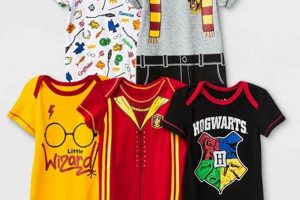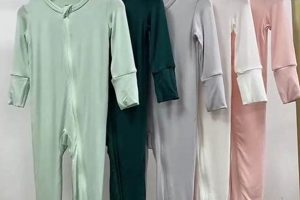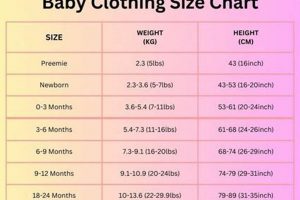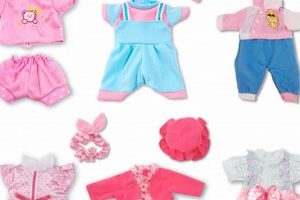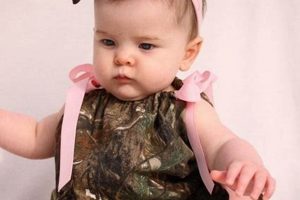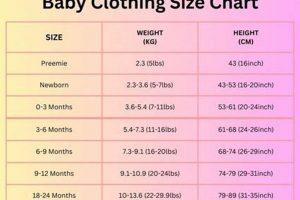Garments designed specifically for infants and toddlers who participate in or are exposed to aquatic activities, particularly surfing, prioritize comfort, protection, and safety. These items often include rash guards, wetsuits, and sun hats constructed from materials that offer UV protection and quick-drying capabilities, mitigating potential hazards associated with sun exposure and prolonged moisture.
The significance of specialized apparel for young children in aquatic environments lies in safeguarding delicate skin from harmful ultraviolet radiation and maintaining a stable body temperature. Historically, readily available swimwear lacked the protective features now standard in infant and toddler surf wear. The development and increasing availability of these purpose-built items reflect a growing awareness of the specific needs of this demographic when participating in outdoor water-based activities. These features contribute to a more secure and enjoyable experience for both the child and caregiver.
The following discussion will delve into the specific materials utilized in the construction of protective swimwear, examine size and fit considerations crucial for comfort and safety, and offer guidance on selecting appropriate garments based on environmental conditions and the child’s individual needs.
Selecting Protective Aquatic Apparel for Infants and Toddlers
The following recommendations offer guidance in choosing appropriate apparel for infants and toddlers participating in, or exposed to, aquatic activities. Prioritizing safety and comfort is paramount.
Tip 1: Prioritize UV Protection: Select garments with a Ultraviolet Protection Factor (UPF) of 50+ to shield delicate skin from harmful solar radiation. Ensure comprehensive coverage, including the neck, shoulders, and arms.
Tip 2: Choose Quick-Drying Materials: Opt for fabrics such as nylon, polyester blends, or neoprene, which minimize the discomfort associated with prolonged moisture exposure. These materials also aid in regulating body temperature.
Tip 3: Ensure Proper Fit: Garments should fit snugly without restricting movement. Ill-fitting items can cause chafing or impede mobility in the water. Consult size charts and consider trying items on prior to purchase.
Tip 4: Consider Wetsuit Thickness: If engaging in activities in cooler water temperatures, a neoprene wetsuit is recommended. The appropriate thickness will depend on the water temperature and the duration of exposure. Seek guidance from experienced surf instructors or retail professionals.
Tip 5: Inspect Seams and Closures: Examine seams for durability and smooth finishing to prevent irritation. Ensure closures, such as zippers or snaps, are secure and located in areas that minimize potential discomfort.
Tip 6: Assess Water Temperature: Base apparel decisions on prevailing water conditions. A rash guard may suffice in warmer water, while a wetsuit is essential in cooler environments. Monitor the child for signs of overheating or chilling.
Tip 7: Incorporate Sun Hats: Utilize wide-brimmed hats constructed from UPF-rated materials to protect the face, ears, and neck from sun exposure. Ensure the hat remains securely in place, especially in windy conditions.
Selecting protective aquatic apparel requires careful consideration of material properties, fit, and environmental conditions. Adhering to these recommendations will contribute to a safer and more enjoyable aquatic experience for infants and toddlers.
The subsequent section will address the maintenance and care of such garments, ensuring their longevity and continued effectiveness.
1. UV Protection and Infant Aquatic Apparel
Ultraviolet (UV) radiation poses a significant threat to the delicate skin of infants and toddlers. Therefore, UV protection is a primary consideration in the design and selection of specialized garments intended for aquatic activities.
- Ultraviolet Protection Factor (UPF) Ratings
Garments designated as “baby surf clothes” often incorporate fabrics with a UPF rating, indicating the level of protection they provide against UVA and UVB rays. A UPF rating of 50+ signifies that the fabric blocks 98% of UV radiation. This rating is crucial for minimizing the risk of sunburn and long-term skin damage. For example, a rash guard constructed from UPF 50+ fabric offers a significantly higher level of protection compared to standard cotton clothing.
- Fabric Composition and Weave Density
The type of fabric and the density of its weave play a critical role in determining its UV protective capabilities. Tightly woven fabrics, such as those constructed from polyester or nylon blends, offer enhanced protection. The inherent properties of these materials, combined with a close-knit weave, reduce the amount of UV radiation that can penetrate the garment. For instance, a densely woven polyester rash guard provides superior UV protection compared to a loosely woven cotton t-shirt.
- Coverage Area and Garment Design
The design of “baby surf clothes” directly impacts the extent of UV protection provided. Garments that offer full coverage of the arms, legs, and neck are preferable to those that leave skin exposed. Long-sleeved rash guards and swimsuits with high necklines are examples of designs that maximize protection. Furthermore, features such as hoods and extended leg lengths further enhance coverage. Leaving no gaps will increase UV protection
- Durability and Maintenance of UV Protection
The effectiveness of UV protective fabrics can diminish over time due to wear, laundering, and exposure to environmental factors. It is essential to follow manufacturer guidelines for garment care to maintain UV protection. Frequent washing and exposure to chlorine can degrade the fibers, reducing their protective capabilities. Proper care, including hand washing and air drying, can extend the lifespan of the UV protective properties of “baby surf clothes.”
The integration of UV protective features into “baby surf clothes” is not merely a marketing consideration; it is a critical element in safeguarding the health and well-being of infants and toddlers exposed to aquatic environments. Choosing garments with high UPF ratings, durable fabrics, and comprehensive coverage is essential for minimizing the risks associated with UV radiation.
2. Material Breathability
Material breathability is a critical factor in the design and selection of garments intended for infants and toddlers participating in aquatic activities. The ability of a fabric to facilitate the passage of moisture vapor and air is essential for maintaining comfort and preventing overheating, particularly in warm or humid conditions.
- Moisture Management and Thermal Regulation
Breathable fabrics allow perspiration to evaporate, preventing the build-up of moisture against the skin. This is crucial for thermal regulation, as excess moisture can lead to discomfort, skin irritation, and even hypothermia in cooler conditions. For instance, a rash guard made from a breathable polyester blend will help wick away sweat, keeping the child comfortable during extended periods of sun exposure and activity.
- Minimizing the Risk of Overheating
Infants and toddlers are particularly susceptible to overheating due to their less-developed thermoregulatory systems. Garments constructed from non-breathable materials can trap heat, increasing the risk of heat rash, heat exhaustion, and even heatstroke. Breathable fabrics, such as those with moisture-wicking properties, allow for better ventilation and heat dissipation, reducing the likelihood of overheating. For example, a lightweight, breathable sunsuit can help keep a baby cool and comfortable while playing on the beach.
- Fabric Selection and Construction
The breathability of “baby surf clothes” is directly influenced by the type of fabric used and the method of construction. Fabrics such as merino wool, bamboo, and certain synthetic blends are known for their breathability. Additionally, garments with mesh panels or strategically placed ventilation holes can further enhance airflow. For instance, a wetsuit with breathable panels in the underarm and groin areas can improve comfort and reduce the risk of overheating during prolonged use.
- Impact on Comfort and Skin Health
Breathable fabrics contribute significantly to the overall comfort of “baby surf clothes”. By preventing the build-up of moisture and allowing for better ventilation, these materials help to minimize skin irritation, chafing, and the development of rashes. This is particularly important for infants and toddlers, who have sensitive skin that is more prone to irritation. For example, a soft, breathable cotton blend can be used as a lining in a wetsuit to improve comfort and prevent chafing.
In conclusion, the selection of breathable materials is essential for ensuring the comfort, safety, and well-being of infants and toddlers participating in aquatic activities. By facilitating moisture management, preventing overheating, and minimizing skin irritation, breathable fabrics contribute to a more enjoyable and healthful experience in and around the water.
3. Secure Fit
The concept of a secure fit is paramount when considering aquatic apparel for infants and toddlers. Garments designed for water activities, particularly those categorized as “baby surf clothes,” must maintain a snug yet comfortable fit to ensure both safety and functionality. This is more than mere comfort; it is a critical factor in preventing hazards and maximizing the garment’s intended benefits.
- Prevention of Water Entry
A secure fit minimizes water entry between the garment and the child’s skin. Excessive water intrusion can weigh down the apparel, hindering movement and potentially causing discomfort or chilling. Well-fitted necklines, cuffs, and leg openings are essential in preventing water from flushing in during activity. For example, a wetsuit with snug-fitting seals at the wrists and ankles significantly reduces water inflow, maintaining the child’s core temperature for a longer duration.
- Freedom of Movement vs. Restriction
Achieving a secure fit should not compromise the child’s range of motion. Garments that are too tight can restrict movement, leading to discomfort and fatigue, ultimately diminishing the enjoyment of the aquatic experience. Apparel should allow for unrestricted arm and leg movements while still maintaining a close fit. A rash guard constructed from a flexible, four-way stretch fabric exemplifies this balance, providing a secure fit without hindering mobility.
- Minimizing Chafing and Irritation
A properly fitted garment reduces the likelihood of chafing and skin irritation. Loose-fitting apparel can rub against the skin, particularly in areas prone to friction, causing discomfort and potential skin damage. A snug fit, achieved through appropriate sizing and design features, minimizes this friction. For instance, flatlock seams on “baby surf clothes” help to eliminate raised edges that can irritate sensitive skin.
- Ensuring Garment Stability
A secure fit ensures that the garment remains in place during aquatic activities. Loose or ill-fitting apparel can shift or ride up, exposing skin to the sun or other elements. Secure closures, such as zippers or snaps, and design elements that conform to the child’s body shape are essential for maintaining garment stability. An example is a sun hat with an adjustable chin strap that prevents it from being dislodged by waves or wind.
These facets collectively highlight the critical role of a secure fit in “baby surf clothes.” The design, material selection, and construction techniques employed in creating these garments must prioritize a fit that balances protection, comfort, and freedom of movement. Apparel that fulfills these criteria contributes to a safer and more enjoyable aquatic experience for infants and toddlers.
4. Water Temperature
Water temperature is a primary determinant in selecting appropriate “baby surf clothes”. Prolonged exposure to low water temperatures can induce hypothermia in infants and toddlers due to their limited ability to regulate body heat. Conversely, excessively thick garments in warmer waters may cause overheating. Therefore, understanding the correlation between water temperature and garment insulation is crucial for ensuring the child’s safety and comfort. For instance, in water temperatures below 70F (21C), a neoprene wetsuit, typically ranging from 2mm to 3mm in thickness, is often recommended to provide adequate thermal protection. The wetsuit traps a thin layer of water between the suit and the skin, which is then warmed by the body, creating an insulating barrier.
The selection process involves considering both the actual water temperature and the duration of anticipated exposure. A child participating in brief, supervised sessions in moderately cool water may require only a long-sleeved rash guard combined with neoprene shorts. This configuration offers some insulation while allowing for greater freedom of movement compared to a full wetsuit. However, extended periods in similar conditions necessitate a full wetsuit to mitigate the risk of hypothermia. The caregiver must continuously monitor the child for signs of shivering or discomfort, which may indicate insufficient insulation. Furthermore, environmental factors such as wind chill can exacerbate the effects of low water temperatures, necessitating adjustments to the selected apparel.
In summary, the relationship between water temperature and appropriate “baby surf clothes” is characterized by a need for balance between thermal protection and mobility. Garment selection requires careful consideration of water temperature, exposure duration, and individual physiological factors. Prioritizing these considerations minimizes the risks associated with temperature extremes, fostering a safer and more enjoyable aquatic experience for young children.
5. Movement Freedom
Unrestricted mobility is a core consideration in the design and selection of garments intended for infants and toddlers participating in aquatic activities. Apparel should facilitate natural movement, enabling unhindered exploration and play within the water, which is intrinsically linked to safety and development.
- Range of Motion
Infants and toddlers require the ability to freely move their limbs to develop motor skills and coordinate movements in the water. Restrictive clothing can impede these developmental processes. “Baby surf clothes” should be designed to allow a full range of motion in the arms, legs, and torso, facilitating swimming, splashing, and other aquatic activities. Garments constructed from flexible materials, such as four-way stretch fabrics, are conducive to uninhibited movement.
- Ergonomic Design
Ergonomic design principles are essential to ensure that “baby surf clothes” conform to the child’s body without constricting movement. Seams should be strategically placed to minimize chafing and irritation, while closures should be designed for ease of use and minimal interference with mobility. For example, a rash guard with flatlock seams and a smooth zipper closure promotes comfort and prevents rubbing during activity.
- Buoyancy and Water Resistance
The design of “baby surf clothes” can influence buoyancy and water resistance. Garments that are overly bulky or absorbent can impede movement in the water. Lightweight, quick-drying materials are preferable, as they minimize water resistance and allow for greater freedom of movement. For instance, a streamlined wetsuit constructed from lightweight neoprene reduces drag and facilitates swimming.
- Psychological Impact
Comfortable and non-restrictive clothing can positively influence a child’s psychological state in the water. Garments that allow for freedom of movement promote confidence and encourage exploration. Conversely, restrictive clothing can lead to discomfort, frustration, and a reluctance to participate in aquatic activities. “Baby surf clothes” should be designed to instill a sense of freedom and encourage a positive relationship with the water.
The design and selection of “baby surf clothes” must prioritize unrestricted movement. By considering range of motion, ergonomic design, buoyancy, and the psychological impact of clothing, caregivers can ensure that infants and toddlers have the freedom to explore and enjoy aquatic environments without limitations.
6. Durability
The longevity of “baby surf clothes” is a significant consideration, given the frequent use and demanding conditions to which these garments are subjected. Durability, therefore, directly impacts the value proposition and long-term cost-effectiveness of such apparel. This is especially important considering the rapid growth rate of infants and toddlers, which often necessitates frequent clothing replacements.
- Material Resistance to Degradation
Fabrics employed in the construction of “baby surf clothes” must withstand repeated exposure to saltwater, chlorine, and ultraviolet (UV) radiation, all of which contribute to material degradation. Higher-quality materials, such as solution-dyed fabrics or those treated with UV inhibitors, exhibit greater resistance to fading, weakening, and eventual breakdown. For example, a rash guard constructed from a polyester blend treated with a chlorine-resistant finish will maintain its integrity and color vibrancy for a longer duration compared to one made from untreated cotton.
- Seam Strength and Construction Techniques
The integrity of seams is critical to the overall durability of “baby surf clothes.” Weak or poorly constructed seams are prone to tearing or unraveling, rendering the garment unusable. Reinforced seams, such as those employing flatlock stitching or double-needle construction, provide superior strength and resilience. A wetsuit with reinforced seams at stress points, such as the shoulders and crotch, is less likely to fail under the strain of repeated use and stretching.
- Resistance to Abrasions and Snagging
Infants and toddlers are prone to engaging in activities that can subject their clothing to abrasions and snags. Garments intended for aquatic use should be constructed from fabrics that are resistant to these types of damage. Tightly woven materials with a smooth surface finish are less likely to snag on rough surfaces, such as rocks or pool edges. A swimsuit made from a durable, snag-resistant nylon fabric will better withstand the rigors of active play compared to one made from a delicate knit.
- Hardware Longevity and Corrosion Resistance
Any hardware components, such as zippers, snaps, or closures, must be able to withstand repeated use and exposure to harsh environmental conditions. These components should be constructed from corrosion-resistant materials, such as stainless steel or durable plastics, to prevent rusting or deterioration. A wetsuit with a corrosion-resistant zipper is less likely to malfunction or seize up after repeated exposure to saltwater.
The durability of “baby surf clothes” is contingent upon a combination of material selection, construction techniques, and hardware quality. Garments that prioritize these factors will provide a longer lifespan, offering enhanced value and reducing the need for frequent replacements. This consideration is particularly relevant for parents seeking to minimize both environmental impact and financial expenditure.
7. Easy Changing
Facilitating swift and uncomplicated garment transitions is a pivotal design consideration in the realm of infant and toddler aquatic apparel. Given the inherent challenges of dressing and undressing young children, particularly in environments often characterized by moisture and limited space, the ease of changing directly influences both the caregiver’s experience and the child’s comfort.
- Closure Mechanisms and Accessibility
The implementation of user-friendly closure systems is paramount. Snaps, zippers, and strategically positioned Velcro closures offer alternatives to more cumbersome fastening methods, such as ties or small buttons. Wide necklines and expandable openings further simplify the process of slipping garments over the childs head and limbs. For example, a rash guard featuring a full-length back zipper significantly reduces the effort required to remove the garment, especially when wet.
- Fabric Properties and Reduced Friction
The selection of materials plays a crucial role in minimizing friction during garment changes. Smooth, quick-drying fabrics such as polyester or nylon blends glide more easily over the skin compared to rougher or absorbent materials like cotton. These materials also prevent the garment from clinging to the childs skin when wet, further streamlining the changing process. For instance, a swimsuit constructed from a slick, water-repellent fabric can be removed with greater ease than one made from a textured or absorbent material.
- Garment Design and Simplified Construction
Streamlined garment designs, devoid of unnecessary embellishments or intricate layers, contribute to ease of changing. Single-piece designs, such as rompers or sunsuits, eliminate the need to coordinate multiple items, reducing the overall complexity of the dressing and undressing process. Similarly, garments with minimal seams and internal tags minimize potential sources of irritation and snagging, facilitating smoother transitions. An example is a one-piece sunsuit with snap closures at the inseam, allowing for quick diaper changes without requiring complete removal of the garment.
- Size and Fit Considerations for Efficiency
An appropriately sized garment, offering a balance between a snug fit and sufficient room for movement, optimizes the changing process. Garments that are too small or restrictive can be difficult to maneuver over the childs body, while those that are excessively large may bunch or snag, hindering efficient transitions. Clear sizing guidelines and adjustable features, such as elastic waistbands or adjustable straps, enable caregivers to select garments that are both comfortable and easy to manage. For example, a pair of neoprene shorts with an adjustable drawstring waistband can accommodate varying waist sizes while ensuring a secure and comfortable fit.
The integration of these design and material considerations into “baby surf clothes” directly addresses the practical challenges associated with dressing and undressing infants and toddlers in aquatic settings. By prioritizing ease of changing, manufacturers can enhance the overall user experience, promoting both the child’s comfort and the caregiver’s convenience.
Frequently Asked Questions
The following section addresses common inquiries regarding the selection, usage, and care of specialized aquatic apparel designed for infants and toddlers. This information is intended to provide clarity and guidance to caregivers seeking to ensure the safety and comfort of their children in aquatic environments.
Question 1: At what age is it appropriate to introduce specialized aquatic apparel to infants?
There is no specific age threshold. However, it is generally recommended to introduce such apparel when the infant is able to hold their head up independently and is participating in supervised aquatic activities. Consult with a pediatrician prior to introducing infants to aquatic environments.
Question 2: How does one determine the correct size of “baby surf clothes”?
Refer to the manufacturer’s sizing chart, which typically correlates height, weight, and chest measurements to garment size. It is advisable to measure the child accurately and select the size that aligns most closely with their dimensions. A snug, yet comfortable fit is essential.
Question 3: Can “baby surf clothes” completely eliminate the need for sunscreen?
No. While specialized apparel offers significant UV protection, it is crucial to apply broad-spectrum, water-resistant sunscreen to all exposed skin areas. Garments provide coverage, but sunscreen is essential for areas not covered by clothing.
Question 4: What is the recommended frequency for laundering “baby surf clothes”?
Garments should be rinsed with fresh water after each use to remove salt, chlorine, and other contaminants. Periodic laundering with a mild detergent is recommended to maintain hygiene and fabric integrity. Refer to the manufacturer’s care instructions for specific guidance.
Question 5: How does one assess the warmth level of a wetsuit for a baby?
Wetsuit thickness, measured in millimeters, indicates its thermal insulation capacity. Thicker wetsuits provide greater warmth. Consult with experienced surf instructors or retail professionals to determine the appropriate wetsuit thickness based on water temperature and anticipated exposure duration.
Question 6: What are the key indicators that a garment is no longer suitable for use?
Signs of wear, such as tears, fading, or loss of elasticity, indicate that a garment may no longer provide adequate protection or functionality. Replace worn or damaged items promptly to ensure continued safety and comfort.
Prioritizing the correct apparel selection, meticulous maintenance, and diligent monitoring of garment condition are essential for safeguarding the well-being of infants and toddlers in aquatic environments.
The following discussion will address potential safety hazards associated with “baby surf clothes” and provide guidance on risk mitigation strategies.
In Conclusion
The preceding discussion has explored the multifaceted considerations surrounding specialized aquatic apparel for infants and toddlers, frequently identified as “baby surf clothes”. Crucial aspects examined include UV protection, material breathability, secure fit, water temperature suitability, freedom of movement, durability, and ease of changing. Understanding these factors is paramount in selecting garments that promote both safety and comfort within aquatic environments.
Prioritizing informed decision-making in the selection and utilization of “baby surf clothes” is a fundamental responsibility. By adhering to the guidelines and recommendations outlined herein, caregivers can significantly mitigate potential risks and foster a more secure and enjoyable aquatic experience for young children. Continued vigilance and awareness remain essential to ensuring the well-being of infants and toddlers during water-based activities.


